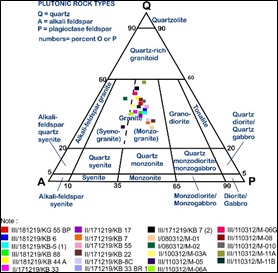Comparison of Granitoid Characteristics West Kalimantan and Karangsambung Based On Mineralogical And Geochemical Aspects
DOI:
https://doi.org/10.25299/jgeet.2021.6.3.7417Keywords:
Granite, Mineralogy, Geochemical, Petrogenesis, West Kalimantan, KarangsambungAbstract
Indonesia was included in the ring of fire so that it has various types of tectonic products, one of which is granitoid. Granitoid is very complex rock and many are found in Indonesia. Some of them are found in West Kalimantan and Karangsambung. Basis of the reasearch is there is no research that compares granitoid in two regions. The purpose of this study was to compare rock characteristics and granite petrogenesis of West Kalimantan and Karangsambung. The research method used was collecting data on field, also laboratory analysis of rock samples using a polarization microscope, refraction microscope, and X-Ray Fluorescence analysis. The mineralogical characteristics of each study area tend to be almost the same. The predominant composition of the main minerals is quartz, plagioclase and orthoclase. But specifically the rock samples from West Kalimantan have been altered from phylic-silicification-propylitic. The entire study area contained accessory minerals, namely apatite, zircon, titanite, and for monazite only in the West Kalimantan sample. There was mineralization up to the supergene stage in the presence of the characteristic minerals for the supergene covelite and chalcocytes in the West Kalimantan sample. Geochemical analysis of both regions shows the same magma affinity, namely Calc Alkaline - High K Calc Alkaline. For West Kalimantan, the value of A / CNK <1.1 has a type metaluminious and > 1.1 a type peraluminious. Meanwhile, Karangsambung A / CNK value <1.1 has a type metaluminious. So that West Kalimantan granite has two I-type and S-type. While Karangsambung is I-type. West Kalimantan granite is formed in continental arc granite (CAG) and continental collision granite (CCG). Meanwhile, Karangsambung in Volcanic Arc Granite (VAG). It can be concluded that the granites of the two regions have quite different characteristics even though they belong to a relatively similar tectonic environment.
Downloads
References
Asikin, S. et al. (1992) ‘Peta Geologi Lembar Kebumen, Jawa, Pusat Riset dan Pengembangan Geologi, Indonesia, Skala 1:100.000’.
Barbarin, B. (1999) ‘A review of the relationships between granitoid types, their origins and their geodynamic environments’, Lithos, 46(3), pp. 605–626.
Browne, P. R. L. (1991) Hydrotermal Alteration and Geothermal System. Lecture Handout, The University of Auckland.
Chappel, B. W. and White, A. J. R. (1974) ‘Two contrasting granite types.’, Pacific Geology, 8(2), pp. 173–174.
Chappell, B. W. and Stephens, W. E. (1988) ‘Origin of infracrustal (I-type) granite magmas’, Transactions of the Royal Society of Edinburgh: Earth Sciences, 79(2–3), pp. 71–86.
Ilmawan, I. (2019) Geologi, Geologi, Alterasi Hidrotermal Dan Mineralisasi Pada Endapan Epitermal Sulfidasi Rendah – Menengah Di Desa Monterado, Kecamatan Monterado, Kabupaten Bengkayang, Provinsi Kalimantan Barat (Skripsi). Departemen Teknik Geologi, Fakultas Teknik, Universitas Gadjah Mada.
Isyqi, Hastria, D. and Ansori, C. (2016) ‘Klasifikasi Granitoid Karangsambung Berdasarkan Data Petrografi Dan’, Prosiding Geotek Expo Puslit Geoteknologi LIPI, (October 2017), pp. 978–979.
Mustafa, M. A. and Usman, E. (2016) ‘Analisis Perbandingan Geokimia Granit Dan Sedimen Dasar Laut Di Pulau Singkep Bagian Timur, Provinsi Kepulauan Riau’, Jurnal Geologi Kelautan, 11(3), p. 131.
Pearce, J. A., Harris, N. B. W. and Tindle, A. G. (1984) ‘Trace element discrimination diagrams for the tectonic interpretation of granitic rocks’, Journal of Petrology, 25(4), pp. 956–983.
Peccerillo, A. and Taylor, S. R. (1976) ‘Geochemistry of eocene calc-alkaline volcanic rocks from the Kastamonu area, Northern Turkey’, Contributions to Mineralogy and Petrology, 58(1), pp. 63–81.
Prasetyadi, C. (2007) Evolusi Teknik Paleogen Jawa Tengah Bagian Timur (Disertasi Doktor). Institut Teknologi Bandung (Tidak Tertbit).
Pulunggono, A. and Martodjojo, S. (1994) ‘Perubahan Tektonik Paleogene – Neogene Merupakan Peristiwa Tektonik Terpenting di Jawa’, in Proceeding Geologi dan Geotektonik Pulau Jawa, Percetakan NAFIRI. Yogyakarta, pp. 37–49.
Setiawan, N. I. and Novian, M. I. (2015) ‘Petrologi, geokimia dan umur batuan granitoid di komplek luk- ulo, karangsambung, kebumen, jawa tengah’, PROCEEDING, SEMINAR NASIONAL KEBUMIAN KE-8 Academia-Industry Linkage,.
Shand, S. (1943) ‘Eruptive Rocks. Their Genesis Composition. Classification, and Their Relation to Ore-Deposits with a Chapter on Meteorite’, John Wiley & Sons, New York.
Soeria-Atmadja, R., Noeradi, D. and Priadi, B. (1999) ‘Cenozoic magmatism in Kalimantan and its related geodynamic evolution’, Journal of Asian Earth Sciences, 17(1–2), pp. 25–45.
Streckeisen, A. (1976) ‘To each plutonic rock its proper name’, Earth Science Reviews, 12(1), pp. 1–33.
Sun, S. S. and McDonough, W. F. (1989) ‘Chemical and isotopic systematics of oceanic basalts: Implications for mantle composition and processes’, Geological Society Special Publication, 42(1), pp. 313–345.
Suwarna, N. de Keyser, R. Langford, R.P. Trail, D.S (1993) ‘Geologi Lembar Singkawang, Kalimantan, skala 1 :200.000’.
Widana, K. S. and Priadi, B. (2015) ‘Karakteristik Unsur Jejak Dalam Diskriminasi Magmatisme Granitoid Pulau Bangka’, Eksplorium, 36(1), p. 1.
Wilson, B. M. (1989) Igneous Petrogenesis A Global Tectonic Approach. 1st edn. Springer Netherlands.
Van Bemmelen, R. W. (1949) ‘The Geology of Indonesia. General Geology of Indonesia and Adjacent Archipelagoes’, Government Printing Office, The Hague, pp. 545–547; 561–562.

Downloads
Published
Issue
Section
License
Copyright @2019. This is an open-access article distributed under the terms of the Creative Commons Attribution-ShareAlike 4.0 International License which permits unrestricted use, distribution, and reproduction in any medium. Copyrights of all materials published in JGEET are freely available without charge to users or / institution. Users are allowed to read, download, copy, distribute, search, or link to full-text articles in this journal without asking by giving appropriate credit, provide a link to the license, and indicate if changes were made. All of the remix, transform, or build upon the material must distribute the contributions under the same license as the original.










